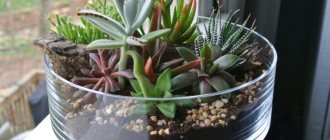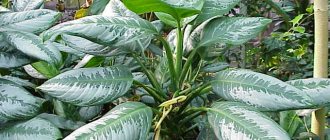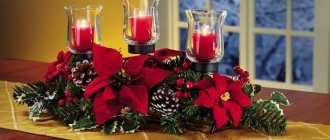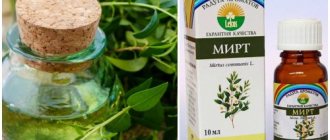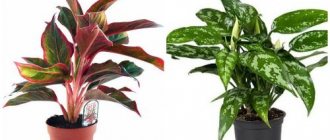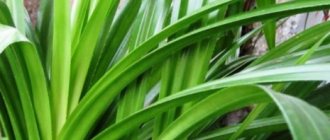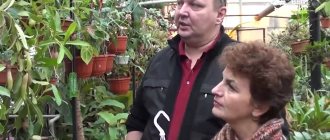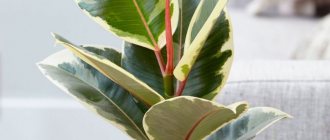History of Philodendron
In the period from 1932 to 1935 There was a bloody war between Bolivia and Paraguay. Covering the chronicles of these military events, journalists from all countries wrote about cannibal plants. So in their articles, reporters wrote that the remains of soldiers are regularly found under the same tree. Their bodies are drained of blood and covered with huge leaves.
The journalists' version said that in South America there is a certain tree whose flowers exude a hypnotic aroma that attracts people. People, intoxicated by the smell of the plant, go to it in fascination. Then the plant grabs the person and tightly entwines it with its foliage, with the help of which it sucks all the blood from its prey.
This scary monster from the jungle turned out to be Philodendron.
The reporters' tales of course attracted attention from the scientific world. However, research has completely refuted them.
Philodendrons form huge shady thickets in nature, close to a water source. Their flowers smell really nice to attract insects for pollination. But they have neither a poisonous nor a narcotic effect on people. And of course they do not feed on human blood.
And the wounded soldiers simply tried to hide from their enemies in the shade and coolness of the philodendron, dying from blood loss caused by numerous wounds.
However, this is not the first and not the last mention of Philodendron.
This plant has attracted the attention of the ancient peoples of South America for centuries; modern scientists never cease to study and experiment with the mysterious flower. It was loved by both florists and home gardeners for its variety of species and decorative foliage.
Reviews
It grows quite quickly; at my work this vine grew more than 4 meters. In a very bright place, its leathery, spear-shaped leaves acquire a bronze tint. The wrappers of the young leaves are very beautiful - they are almost red. A completely unpretentious plant, suitable even for northern windows. In the summer I take him out to the balcony - he feels great there even in the heat. With a lack of moisture, the leaves wither slightly, but after watering the turgor is restored. It can grow like a vine or, if pruned, like a “bush.”
Svetlana Yurievna https://irecommend.ru/content/krasneyushchii-tsvetok
The plant is very unpretentious and very grateful, stubborn in its desire to survive and grow further))) It grows slowly - about 1 cm per year.
keygen https://otzovik.com/review_476964.html
Very unpretentious! Calmly tolerates low air humidity and short-term drying out of the earthen coma. If you give it nutritious, loose, slightly acidic soil and diffused light, then there will be no problems! A very grateful and responsive plant!
sweetsvetulia https://www.flowersweb.info/forum/forum44/topic102067/message3283387/#message3283387
Description of the plant
Philodendron is a member of the Araceae family. The name comes from two Greek words “φιλέω” - “love” and “δένδρον” - “tree”.
There are almost a thousand varieties of Philodendrons in nature.
It is an evergreen, flowering, perennial herbaceous plant native to the tropical forests of South America. From this continent, Philodendron spread throughout the planet and can now be found even in the rainforests of Australia and New Zealand. Philodendrons have life forms of hemi-epiphytes, epiphytes, semi-epiphytes, subshrubs, terrestrials and lianas.
Philodendrons dominate other tropical plants. They can be found along roads, various fresh water bodies, on rocks and plains. They climb other plants and spread along the ground, occupying significant spaces. These are werewolf plants. They can adapt to any natural landscape and conditions, changing life forms - transforming from a terrestrial plant into an epiphyte, releasing aerial sucker roots.
Philodendron White Knight
A mystery that scientists cannot solve to this day is the foliage of Philodendron. The plant, for some unknown reason, produces two types of leaves at the same time. Some leaves are scaly with a bud from which new shoots grow. And others are ordinary ones on a petiole. Flowers grow from leaves with a petiole. At the same time, some leaves, regardless of their type, remain with the plant until the end of its life, while others are regularly shed by the philodendron. Scaly and regular leaves alternate with each other.
In gardening, Philodendron has taken root precisely because of the diversity and beauty of ordinary leaves. They are presented in the form of arrows, ellipses, and hearts. Leaf blades are dissected, pinnate and whole. At the same time, as the plant develops and ages, the leaves transform from arrows into hearts.
Not only the shape, but also the color of the foliage is in a process of constant change. Changes in color are caused by any external influences and the age of the plant. However, there is one general tendency - the outer part of the leaf always has a darker shade than the inner one.
Such endless changes within one species over the course of two hundred centuries made it impossible for botanists to correctly describe this amazing group of plants.
Philodendron flowers have the shape of a spadix, covered with a petal-veil. The color of the petal is two-tone - white light green or red turning into burgundy. The flowers have a persistent sweetish aroma. The flowers produce large, fleshy berries. The fruits are edible and taste similar to bananas.
In addition to edible fruits, Philodendrons have other beneficial properties that are used in human life. Thus, ropes are made from aerial roots, and baskets are made from bark. The latex of some Philodendron species is an antiseptic and is used in medicine.
In addition, the juice of the plant is used as glue. The dye used to make red paints is extracted from the flower bedspread. Philodendron juice was also part of the curare poison. Currently, such juice is part of a poisonous mixture for stunning fish.
In turn, philodendron juices are not poisonous; intoxicating substances are produced in them only during the fermentation process.
Philodendron leaves perfectly filter the air from pollution, and also predict the weather - a day before the rain begins, the plant is covered with dew drops.
How to propagate Philodendron yourself
Most often, gardeners propagate philodendron by cuttings - this is the easiest and most reliable way. Both apical and stem shoots are suitable - the main thing is that they have at least two leaves. The most suitable case: an area with aerial roots. The cuttings are planted in sphagnum or sand-peat mixture, covered with a transparent film and maintained at a temperature of 25 degrees above zero.
Cuttings of some varieties of philodendron take root well in water, but soil rooting is still preferable, because in this case the roots will not have to adapt when transplanted into the ground.
If rot appears on the cut, cut off the damaged area and treat the cut with crushed coal. After this, you can try to root the sprout in the soil again.
You can also root a stem cutting that has no leaves. It needs to be laid on moistened moss and the container placed in a warm place. Perhaps the cuttings will not develop roots, but a bud will awaken from which a shoot will sprout. When it reaches 5-6 cm, it is cut and rooted. And on the “stump”, after some time, a new bud can sprout.
In order to propagate philodendron by leaf, the leaf is cut off at the heel and placed in water. You can plant it in light soil, but in this case the container must be placed in a bag and ventilated regularly. You can tell that the plant has successfully taken root when a new leaf appears.
When propagating by air layering, the shoots of vines are simply fixed to the ground until roots appear at their nodes. As soon as this happens, the rooted shoot is cut off from the parent plant.
In the case of tree-like philodendrons, a ring cut is made in the spring on their woody trunks. A second one is made 3 cm lower or higher, and the bark between them is removed. The exposed cut is treated with a root former, wrapped in moistened moss and wrapped in polyethylene.
The moss needs to be constantly moistened, and then after a few months roots will appear there. A couple of months after their appearance, the film and moss are removed, the trunk underneath is cut off and planted in a container. Do not rush to throw away the remaining stump: most likely, new shoots will appear on it over time.
Decorative types, names with photos
Philodendron verrucosum
The regular leaves are heart-shaped and have a velvety texture. The length of the leaf plate is 20 centimeters and the width is 10. The color is dark green, with shining bronze veins. The cover of the flower is pale yellow.
Philodendron Erubescens
The shoots of the plant can reach a length of up to two meters. Therefore, this species is suitable as an ampelous plant. The leaves are oval-shaped, 30 centimeters long and 25 centimeters wide. The color of the upper part of the leaf blade is green, and the lower part is red.
Philodendron Scandens
An ampelous plant with medium-sized heart-shaped leaves (15cm×10cm). The color is green, monochromatic, glossy.
Philodendron Atom / Philodendron Atom
Decorative, low-growing bush. Short stems produce petiolate leaves 30 centimeters long. The sheet is cut into five parts, the edges of each forming bends in the form of waves. The foliage color is green, with a glossy tint.
Philodendron Ivy / Philodendron Hederaceum
This species is represented by a vine whose shoots stretch up to six meters. Regular leaves are heart-shaped, thirty centimeters long. Their color is dark green. The flowers are very showy - pale red ears in a light green petal cover.
Philodendron Sello or Bipinnate Philodendron / Philodendron Bipinnatifidum
This species has the ability to transform. The maximum size of the stems, covered with dense bark, reaches three meters. The petiolate leaves are triangle shaped and khaki colored and consist of two parts. However, triangles can take on the shape of hearts and also change color to green.
Philodendron Panduriforme
The stems of this vine climb up the supports. Their maximum length does not exceed two meters. Young petiolate leaves have an elongated heart-shaped shape. With age, the center of the leaf blade “thinner” and takes on the shape of a guitar. The foliage color is stable - bright green.
Philodendron Laciniatum
The lobed philodendron is also a vine whose leaves are capable of changing. Ideally oval leaf plates turn into three-fingered, and subsequently five-fingered. The foliage color is green.
Philodendron Evans / Philodendron Evansii
This species is attractive due to the size of its petiolate leaves. The leaf blades grow up to a meter in length and up to 50 centimeters in width. These leaves change shape from triangles to hearts. The edges of the plate form a wave. The color of the foliage is also changeable and young specimens have a bronze cast, against which green veins appear as clear lines. Mature leaves become a solid green.
Philodendron Radiatum
Due to its rapid growth, this vine is valued by landscape designers and is perfect for landscaping parks, arches, garden plots and interior walls. The length of the shoots reaches three meters. The main leaves are small, dissected-oval, green.
Philodendron Elegans / Philodendron Elegans
Both the foliage and the flower are valued in this species. The plant has one shoot, which becomes woody with age. Petioled leaves almost a meter long grow on this shoot. They have a deep cross section and a rich dark green color. The flower consists of a spadix covered with a matte pale green petal spathe, the edges of which are framed by a pink stripe.
Philodendron Xanadu / Philodendron Xanadu
Also a vine with half-meter foliage. The leaf blade is soft, airy and feathery. Color: emerald.
Care problems
When a philodendron is lethargic, the leaves turn yellow or curl, drying out, the reason is not always an attack by harmful insects or a fungal disease. Often, the deterioration of the condition of a tropical perennial plant is a consequence of violations of agricultural practices. If a philodendron is not properly cared for, it shows this by deteriorating its appearance. There may be such manifestations:
- Wilting of foliage, yellowing or browning of its tips - an excess of nutrients in the substrate.
- Slowing growth, reducing the size of leaf blades, their pallor and yellowing of the ends is a lack of nutrients in the soil mixture.
- Small, pale leaves - lack of lighting.
- Loss of elasticity of foliage - excessively bright lighting.
- Brownish marks on the leaves are sunburn due to improper placement of the container with the philodendron.
- Brownish or brownish leaf blades - there is a great lack of watering.
- Yellowed leaves mean frequent overflows; stagnation of liquid in the soil mixture is also possible.
- Dark marks appear on the foliage or there are spots near the veins of a brown-green color - the plant is overcooled.
- Brown, wrinkled leaves - insufficient air humidity or excessively high temperature in the room where the tropical perennial is located.
On a note!
When the soil is chosen incorrectly - it is heavy - the substrate quickly compacts and takes a long time to dry, increasing the likelihood of liquid stagnation.
Philodendron is a beautiful decorative deciduous plant that does not require special attention. This tropical perennial tolerates partial shade well, but it is better to place it in a sufficiently lit place so that direct sunlight does not fall on it. The plant is warm and moisture-loving, but can hardly tolerate heat and overflow. The indoor flower is almost immune to disease, but it is often attacked by pests. However, most problems with philodendron are the result of serious violations of agricultural practices.
Home care
Lighting
To grow philodendrons, you need well-lit places, but the light should be diffused. If there is insufficient lighting, the plant will begin to change the shape and color of the foliage.
Temperature
Philodendrons prefer stable temperatures between 18-25 degrees. Without fluctuations and drafts.
Watering and humidity
Philodendrons should only be watered with filtered, settled water at room temperature. The soil in the pot should be constantly moist, but not wet. After abundant watering, all excess water is immediately drained from the pan.
Moist air is vital for philodendrons. Therefore, the place where the pot with the plant stands needs to be equipped with humidifiers, spray water over the crown every day, wipe the leaves with a damp sponge and even bathe in the shower.
Because of their love for moisture, Philodendrons are often used for landscaping and decorating bathrooms and saunas.
Philodendron Sello
Priming
Philodendrons require light soil with neutral acidity. For the substrate mixture, you can use sand, peat, perlite, crushed coniferous bark, turf or leaf, as well as ordinary garden soil, in equal proportions.
To prevent root rot, it is important to fill the bottom of the pot with expanded clay or broken brick for drainage, and add charcoal or dried moss to the substrate.
Fertilizers
In the cold months (October - April), mixtures of mineral fertilizers must be added to the soil once every 30 days. And in the warm season (May - September) the plant needs organic substances.
At the same time, philodendrons cannot tolerate nitrogen, and fertilizing containing this element should be avoided. Due to excess nitrogen, the foliage of the plant will lose its decorative color.
Trimming
Philodendron stems grow very intensively. They should be trimmed as they grow to maintain their size and decorative shape. The cut areas should be treated with activated carbon powder.
Transfer
The earthen part of the philodendron root system is very compact and its growth is almost invisible. The plant prefers a compact pot. You should not disturb the philodendron with frequent transplants and carry out such manipulations more often than once every 3-5 years.
Philodendron diseases and difficulties encountered during cultivation
| Problem | Cause |
| Tips and edges of leaves dry out | Insufficient watering |
| Tips and edges of leaves dry out | The air is too dry |
| The leaves wrinkled and turned brown | |
| Tips and edges of leaves dry out | Too little watering |
| Leaves lose their variegated color and characteristic dissection | |
| The brown edge on the edges of the leaves expands | Overwatering |
| Leaves grow small | |
| Small and pale new leaves | Little light |
| Elongated shoots | |
| Leaves lose their variegated color and characteristic dissection | |
| Light or brown dry spots on the surface of the leaves | The sun is too bright |
| Pale leaves | |
| Leaves curl down | Excess fertilizer |
| New terminal leaves grow small and yellow | Lack of fertilizers |
| The leaves lose their variegated color and characteristic dissection. | |
| Leaves lose their variegated color and characteristic dissection | Hypothermia |
| The leaves turn black |
Pests that philodendron is susceptible to include traditional scale insects, mealybugs and spider mites. The methods of dealing with them are simple - store-bought or even folk remedies.
A serious cause for concern is the rotting of philodendron stems. This most often occurs due to the fact that the vine growing in heavy soil is over-watered at low temperatures.
But yellowing and falling of the lower leaves is a natural process of plant aging.
Another natural phenomenon is the appearance of water droplets on philodendron leaves. This happens before rain and is caused by high air humidity, when the plant can no longer evaporate moisture into the air due to its excess. In this case, you need to wait a little longer with moisturizing, perhaps even reduce watering.
Philodendron propagation methods
Seeds
It is not possible to propagate all types of Philodendrons from seeds at home. Plants have a very complex mechanism of pollination, fertilization and germination. Therefore, this method is only possible in nature, or in high-tech greenhouses.
Cuttings
The shoots or leaves remaining from pruning are used as planting material for propagating philodendrons at home.
For cuttings, twigs with several internodes or petioles from leaves with a whole bud are suitable.
The cuttings are laid horizontally in a damp mixture of sand and peat, and placed under film or glass. The petioles begin to take root within a month, after which they can be picked up and placed in separate containers.
Horizontal layering
The bark on one of the side shoots is cut with a sharp, sterilized blade. The cut site is wrapped with sphagnum. The moss is moistened with a spray bottle several times a day. After a month, roots will sprout on the shoot, then the shoot is cut off and planted in a substrate for philodendrons as an independent plant.
Features of planting and transplanting
Tropical vines require a lightweight substrate that is water- and breathable. The reaction of the selected soil must be neutral or slightly acidic. In the natural environment, philodendrons grow in soil that contains a high content of rotted wood and fallen leaves. In the case of a purchased mixture, a Saintpaulia substrate is suitable. When making a soil mixture yourself, you need:
- garden soil - 3 parts;
- orchid bark – 4 lobes;
- perlite – 1 part;
- peat mixture – 2 shares.
But it is also possible to create another substrate, which will contain turf soil, leaf turf and sand in proportions of 1:3:1. It is possible to add a little bone meal (horn shavings) to the soil mixture to increase the nutritional value of the substrate for philodendron. Also, if the perennial is not a bush plant, a support is immediately prepared for it - for small specimens, a “ladder” made of strong wire, and for adult plants, a purchased one is also suitable.
On a note!
If the support is made of a pipe, then it is kept slightly moist, and during the growing season it is regularly sprayed with diluted fertilizers of low concentration.
Adult specimens are replanted once every 2-3 years; in the case of young ones, they need a new larger container annually. The procedure is carried out using the transshipment method, without damaging the earthen coma. When the philodendron is too large, the top layer of the substrate is renewed. To do this, remove 5 cm of the old soil mixture. It is better to replant the plant in the spring season.
A transplant must be done in the following situations:
- The substrate has become excessively dense or moss has begun to grow on it.
- The roots of the plant are visible from the drainage holes or the leaf blades gradually become smaller.
- There are pests in the soil or the philodendron looks sick.
- Whitish stains appeared on the surface of the soil mixture in the pot.
The container where the philodendron will be transplanted must have drainage holes. The plant also needs a layer of expanded clay or other material with similar properties. After transplantation, the philodendron is shaded and watering is reduced until the plant adapts (approximately 2 weeks). When a perennial has been purchased in a store, it is transplanted into a permanent container immediately, while the root system is inspected. When the rhizomes have completely “mastered” the soil, take a pot larger in diameter than the shipping container. The philodendron is buried to the same level as it was, the root collar must remain above the level of the substrate.
Diseases, problems, pests and treatment
Philodendrons are not susceptible to any of the types of diseases characteristic of house plants.
The only problem can be rotting of the earthen root, which begins due to overflow and stagnation of water in the pot. If you exclude the swamp factor, the philodendron will heal itself. But you can help the plant heal faster if you remove parts of the root damaged by rot.
Very rarely, mainly from neighboring plants, thrips, scale insects, spider mites or mealybugs can get on the philodendron. Getting rid of them won't be difficult. One treatment with insecticides or a simple shower is enough.
What you need to know if you want to buy a philodendron
Even if you buy philodendron in a specialty store, you cannot be sure which variety you are getting. This is caused by the above-described property of vines to change the color and shape of their leaves over time and thereby mislead even experienced gardeners. Although you can still try to identify the variety, because some of them have very characteristic differences.
Next, you should focus your attention on the health of the selected philodendron and carefully examine it. Its leaves should not be limp or damaged, and they should not have spots or dry edges. The stem should also be clean, with no signs of rotting or drying out. Check the plant carefully for pests.
The indoor philodendron flower is not the cheapest pet. The price of the most inexpensive plants starts at 2,000 rubles - most often this is a plant 35-40 cm high. Much depends on the species. A meter-high philodendron can cost 7,000, 14,000, or even 32,000 rubles. As a rule, tree-like forms are more expensive for buyers than vines.
You can find out what the male anthurium flower contains and see its photo at this address:
How anthurium is transplanted at home is described in this article.
And this information will be useful to those who do not know how to make anthurium bloom.
Guitar philodendron (P. panduriforme)
As they mature, the leaves of many philodendron species undergo an amazing metamorphosis. From lanceolate or heart-shaped, they turn into feathery, finger-shaped or lobed. Philodendron guitarum is no exception.
This vine, which in nature grows up to 4–6 meters, is almost half that size when grown in pots. But at the same time he does not lose the ability to transform. And adult plants amaze with their bizarre three-lobed leaves, which reminded botanists of the appearance of the ancient Greek musical instrument, after which this type of philodendron was named.
Sometimes young Philodendron guitarum plants are confused with Philodendron bipinnate, but when these large indoor species mature, the difference between them becomes obvious even to a non-specialist.
Philodendron warty (P. verrucosum)
Among its fellows, the warty philodendron stands out for its versatility and unique appearance of its leaves. If other types of philodendrons rarely change their habits and are either epiphytes or terrestrial plants, then this plant easily adapts to any conditions. It can be found both under the canopy of trees and on them. Climbing vines easily take root in the ground and find food on the branches.
The decoration of the plant is its patterned heart-shaped leaves. Moreover, the purple or brownish ornament formed by green veins is not on the front side, but on the back side. A somewhat compressed leaf blade 15–20 cm long is supported by a long petiole covered with greenish hair.
Philodendron reddish or blushing (P. erubescens)
Another liana in the constellation of philodendron species for home cultivation is the blushing philodendron, which has given gardeners a lot of varieties with original, including variegated heart-shaped or pointed-ovate leaves.
The name of the plant was given by the reddish petioles, internodes, and in some cases, leaf blades of this climbing, almost non-branching vine.
Having noticed a shade unusual for other philodendrons, breeders have now obtained a lot of interesting varieties with pinkish, picture-green, deep purple and marbled leaves.
In addition to increased decorativeness, cultivated varieties of Philodendron blushing have more compact sizes and better adaptability to indoor conditions.
Giant Philodendron (P. giganteum)
The largest representative of the philodendron genus is considered to be the giant philodendron, native to the Caribbean islands and several regions of South America. Living under the canopy of the tropical forest, these plants reach a height of 4–5 meters, and their rounded, heart-shaped leaves can grow up to 90 cm in length.
It is not surprising that such a remarkable species of philodendron was discovered in the middle of the 19th century, and today it adorns the best botanical gardens and greenhouses in the world.
Philodendron ivy (P. hederaceum)
One of the smallest-leaved, miniature and most popular species of philodendron among gardeners, it can also be considered the most ambiguous. Philodendron ivy at different times, and sometimes even today, is called climbing philodendron, brilliant philodendron, clinging or pointed. No other variety can boast of such a wide range of names. However, the plant does not lack human love!
A liana with wide-heart-shaped pointed leaves sitting on long flexible petioles is a favorite indoor plant. In terms of popularity, the plant competes with the similar scindapsus (photo).
In nature, there are specimens with smooth, dark green foliage that can withstand deep shade well. Today, lovers of indoor floriculture have at their disposal not only varieties with marbled lemon and white spots. A variety of Philodendron brilliant has been developed with completely yellow leaves.
